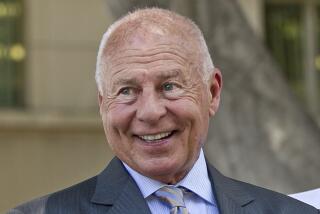Abductions’ eerie similarities
- Share via
SAN FRANCISCO AND ORINDA — Phillip Garrido’s kidnapping and rape of a young woman in 1976, as described in federal court documents, bore eerie similarities to his alleged abduction and captivity of 11-year-old Jaycee Lee Dugard.
The trial transcript and court-ordered psychological evaluations reveal a deeply troubled man who craved violence for sexual satisfaction, meticulously planned the rape and was developing an obsessive interest in religion.
And they show that Katherine Callaway, 25, may not have been his first victim. According to the transcript in his kidnapping trial, prosecutors tried to introduce evidence that Garrido attempted to kidnap another woman.
That alleged assault happened shortly before he abducted Callaway on a November night in South Lake Tahoe and drove her to a Reno storage unit that had been outfitted with multi-colored stage lights, a stack of pornography and a bed covered in a hole-riddled red satin sheet.
He also said on the stand that he masturbated outside of elementary schools and exposed himself to girls he thought were between the ages of 7 and 10.
Garrido, 58, and his 54-year-old wife, Nancy, were arrested last week and charged with 29 felony counts of rape and kidnapping in the 1991 abduction of Dugard, who authorities say bore Garrido two daughters during her captivity.
In 1977, Garrido was found guilty of abducting Callaway and transporting her across state lines. He was sentenced to 50 years in federal prison. He later pleaded guilty to a Nevada rape charge and was sentenced to life in state prison.
In all, however, he spent 10 1/2 years in federal prison for the kidnapping and about seven months in a Nevada prison. He was paroled to California in August 1988, three years before he allegedly kidnapped Dugard.
Thomas W. Hutchison, a spokesman for the U.S. Commission on Parole, said the law at the time of Garrido’s conviction made him eligible for federal parole after 10 years. For sentences 30 years or longer, a convict had to serve at least a third of 30 years. Federal parole was abolished in November 1987, but that applied only to crimes committed after that change.
The federal commission would have held a hearing and considered the rape as well as the kidnapping in deciding whether to parole Garrido, the spokesman said. Hutchison said he did now know why the commission paroled Garrido.
Garrido tried and failed to have his sentence reduced, which would have permitted him to leave federal prison after eight years. In his petition, Garrido’s lawyer said he could become “a very useful citizen and be rehabilitated.”
In a handwritten letter to the court, Garrido blamed his past troubles on marijuana and LSD. He said he had obtained a high school degree in prison and was learning carpentry and drafting. He also planned to take a two-year computer course.
He told the court that he had “progressed very well” in weekly, one-hour sessions with a mental health therapist.
“I have set my goals and find myself well on my way,” he said in neat cursive. “In all respects, my life has changed.” He said that he was “ashamed” of his past and added that his life was “now in control.”
Authorities say the Garridos held Dugard and her two daughters in an unkempt warren of tents, sheds and tarps secreted behind their Antioch-area house, a veritable “backyard within a backyard” constructed so as to be undetectable.
To Michael Malloy, who prosecuted the rape case in Washoe County, there are parallels between the abductions of Callaway and Dugard. Both were snatched from South Lake Tahoe. Both crimes show careful planning.
Garrido “had a place set up specifically for this purpose,” he said. “And it’s eerily similar, it seems to me, to what he was doing with Ms. Dugard in Antioch.”
Planning and premeditation were major themes of the kidnapping trial. Garrido brought tape, a belt and handcuffs with him when he knocked on the driver’s window of Callaway’s Ford Pinto and asked for a ride on Nov. 22, 1976.
As he drove her to the storage unit where he would rape her for five and a half hours, Garrido talked about his sexual fantasies. At one point, a bound and handcuffed Callaway, hoping to remain alive, suggested that they just pull over and get it over with.
“He said, ‘You might as well get that out of your mind,’ ” she testified. “ ‘You are going with me, you have got no choice, I have got it all planned.’ ”
Callaway also testified that she asked Garrido at one point how long he intended to keep her.
“And he said, ‘Maybe I will bring you back tomorrow,’ ” she recounted in court. “And then I really got scared, and I said, ‘Well, you know, where are we going?’ And he said, ‘Far away. I’ve got a shed. I’ve got it all prepared.’ ”
Garrido admitted during the trial that he had kidnapped Callaway and transported her across state lines to fulfill his sexual fantasies.
He tried unsuccessfully to prove that intense LSD use had unhinged him, according to the trial transcript, leaving him unable to understand that his actions were wrong or to stop himself.
Psychiatrists on both sides agreed that Garrido had trouble with drugs and was a sexual deviate.
But they disagreed about whether he understood right and wrong and was competent to stand trial.
Dr. Lynn B. Gerow Jr. wrote in a report for the prosecution that Garrido’s “sexual deviation” could have been caused by four years of daily LSD use, along with regular abuse of marijuana, alcohol and cocaine.
Gerow noted that Garrido said he had taken LSD after abducting Callaway.
Defense attorney Willard Van Hazel had this exchange with the psychiatrist hired to help win Garrido’s freedom.
Van Hazel: “Doctor, do you believe that Mr. Garrido would be a menace to the health, safety and morals of himself and others without psychiatric treatment?”
Dr. Charles P. Kuhn: “I certainly do.”
--
maura.dolan@latimes.com
More to Read
Sign up for Essential California
The most important California stories and recommendations in your inbox every morning.
You may occasionally receive promotional content from the Los Angeles Times.














